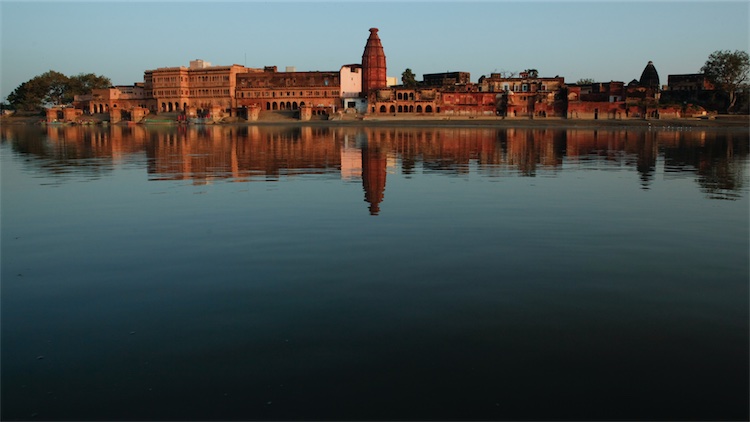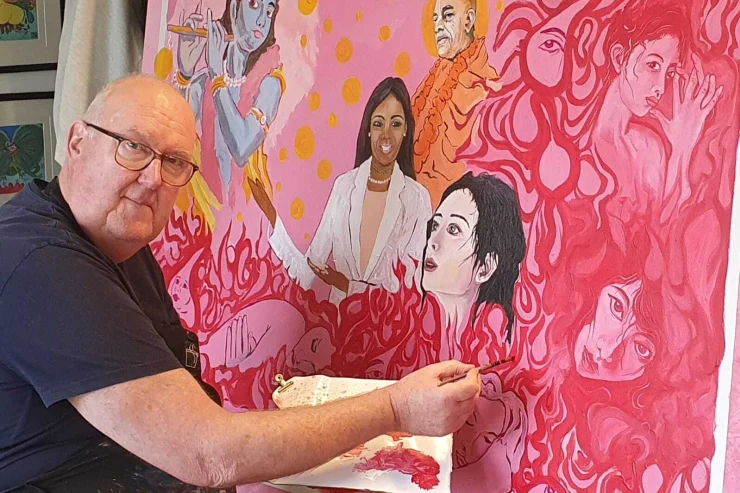Giving Human Rights to the Yamuna Is Not Enough, New Documentary Reveals
By Madhava Smullen | Apr 17, 2017

Recently, a high court in India declared the Yamuna river a living entity, bestowing on her the same legal rights as a person. Many shared the news on social media, excited about this seemingly major move towards cleaning up the heavily polluted river, once called “dead” by the United Nations.
But a closer look shows that the development, while a nice gesture, won’t actually achieve much.
“This status was only given by a court in the Northern state of Uttarakhand, where the Yamuna is already pristine enough to drink and there’s not much pollution,” says Krisztina Danka, Ph.D. (Krishna-lila Dasi), director of the upcoming documentary The Stolen River. “The problem is that according to Indian law every state has a right to all its natural resources, including rivers. So this ruling has absolutely no bearing on the other states further down the river – such as Haryana and Uttar Pradesh – where most of the pollution is actually taking place. Thus it doesn’t solve the problem!”

The pristine Yamuna river in Uttarakhand
The Stolen River, which was nominated for an award at CMS Vatavaran in Delhi – the largest environmental film festival in Asia – digs much deeper to find answers that corporations and certain authorities don’t want us to know.
“That’s the thing about independent filmmakers – we’re not in anybody’s pockets,” says Krisztina. “We have the luxury of being able to tell the truth.”
That truth, dug up through years of investigative journalism by Krisztina’s crew since 2011 – reveals many interesting facts about the plight of the Yamuna. One of these is that we – the average American and European consumer – unknowingly play a part in it and have the power to make a difference.
Along the way to that discovery, there are other things to learn first – much of it shocking.

The Yamuna river at Delhi
The film follows a group of six young people from the Braj area, including simple village girls from Varshana, and one young lady who was born in America and has gone back to find her roots. They can’t understand why their beloved mother Yamuna, a life-giving source, is getting dirtier and dirtier and spreading disease and death amongst their cows, crops and family members. So they set out to find just how widespread the problem is, and what causes it.
In Vrindavan, they find that untreated municipal waste, garbage and sewage are going into the Yamuna. They also talk to doctors who tell them about the water-borne diseases such as typhoid that people can get from such unclean water; and to a gynecologist who tells them that child and infant mortality is unusually high in the region as a result.
Seeking the source of this pollution, they travel up to Delhi, where six feet of foam rolls on top of a black Yamuna filled with garbage and industrial waste. They talk to experts who tell them that nothing can survive in the water – all the fish and plants are gone.
Still, people bathe in it. In a particularly affecting scene in the film, our young investigators watch with horror as a family pushes garbage and dead dogs aside to dunk their tiny baby into the water. When asked if they’re afraid that their child will get sick, they reply, “It’s sacred water no matter what.”
Thus, according to doctors, more than 60% of the population in Delhi and downstream suffer from skin cancer or some other form of cancer. Many children have central nervous system diseases. And the water floods agricultural fields, infusing vegetables with chemicals and heavy metals and causing 23% of children in the region to suffer and die from arsenic and lead poisoning.
Even further north, in Haryana, the youth find that literally all of the fresh, clear Yamuna water coming from its source is diverted at Hathni Kund Barrage. For miles after the Barrage, the riverbed is completely dry. It’s then filled in with groundwater recharge, industrial and human waste in Delhi, and thus reaches Vrindavan, Krishna’s land, with not a single drop of fresh Yamuna water left.

The Yamuna river on the Northern side of Hathni Kund Barrage
Why is it diverted? To irrigate rice fields. And from talking to rice farmers and exporters, the heroes of The Stolen River find out that barely 2% of the rice grown feeds the hungry people of India – in fact, chapatis, rather than rice, is the regional staple. The remaining 98% goes to feed foreigners in the Middle East, Europe, and the United States.
“And over the years, the demand have been increasing,” Krisztina says. “As we have been buying more rice from India – especially basmati – they have been producing more. And to do that, they have been taking more and more water from the Yamuna – up to the point where no a single drop of fresh water left.”
Trying to make a change, the young protagonists from The Stolen River joined grassroots efforts like the Save Yamuna environmental organization; and the Bharatiya Kisan Farmers’ Union. Gathering support, these groups have organized huge protest marches upon Delhi to apply pressure to politicians – in 2015, a total of half a million people marched from Vrindavan to Delhi.
These efforts have brought attention to the Yamuna’s plight. They’ve also drawn promises from politicians to release an adequate amount of environmental flow along the entire course of the Yamuna, and to build a parallel canal to collect and divert sewage away from the river.

The empty riverbed in the Southern side of Hathni Kund Barrage
So far, there has been very little follow-up on these promises: the quality of the water and the quality of the people’s life who depend on the Yamuna have not improved.
That’s where ISKCON temples, individual devotees, and the Indian diaspora in the West – come in.
“We have been unknowingly part of the problem, but we can be part of the solution, too,” Krisztina says. “I don’t think it would be an exaggeration to say that almost every ISKCON temple offers Indian basmati rice to Lord Krishna – rice that is being cultivated on the stolen and exploited Yamuna river and blood of the Brijabasis. How outrageous is that? But we can show the decision makers that foreigners also care by stopping our contribution to the problem. Then we will be working together with the grassroots efforts in Braj, and will have a better chance to make change faster.”
Most of the basmati rice sold in the U.S. and Europe, Krisztina explains, comes from this region of India. But as conscious consumers we can dry up the demand and put an economic pressure on some of the key players in this business simply by purchasing Thai or California rice instead, and instigate very real change.

A rice field in Haryana flooded by Yamuna water
Krisztina hastens to add that this move will not rob the farmers or the rice-exporters of Haryana of their income. “There are many alternative ways to cultivate rice with much less water, which other Indian states like Assam have used,” she says.
Recently, the documentary “Blackfish” about whales in captivity inspired many to refuse such entertainment, causing SeaWorld Orlando to suffer a $15.9 million loss in one year. Film is powerful, Krishna-lila says. And she hopes that her film will make a similar emotional impact on viewers, inspiring them to take action by thinking about their choices.
The director herself was transformed by her experience of making the film. “I’m a mother, so when I saw little infants dying of Yamuna-inflicted diseases, it was very hard emotionally for me,” she says. “During the filming, our crew would film for a while, then spend half-an-hour crying in the bushes.”
But, she says, the film is also about the positive power of cooperation; about how ublikely heroes, or normal people can come together to achieve big results. So far, she’s been inspired by Hindus, Muslims, Sikhs, atheists, young and old, all coming together to speak for the Yamuna. And she hopes people in the West will do their part by ceasing to purchase basmati rice grown with the water of the Stolen River.

Basmati rice at a Haryana market, ready to be exported
“This is important not only for Indians,” she says. “We are one global community.”
Krisztina felt that The Stolen River was so important that she did not take a salary for making the film, and used her own family’s savings to cover most of the travel and shooting expenses.
Now she is editing the film down from its original length to a length more suitable for international audiences, TV broadcast, and use as an educational tool. She needs to raise $45,000 to complete the film so that she can inspire viewers en masse and make a difference in the lives of millions.
“Even a donation of $5 or $10 will help,” she says.
* * *
To make a donation and help complete the film, please visit https://www.generosity.com/community-fundraising/the-stolen-river-film-help-rescue-the-yamuna–2















